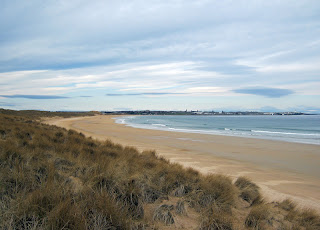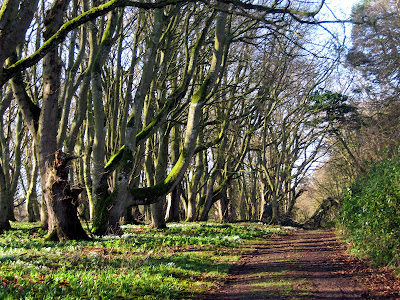 |
| The Broch beach from the dunes at Water of Philorth |
Tuesday, 28 February 2012
February Heatwave
Monday, 27 February 2012
Portsoy: a rare iron and stone gravemarker
| A magnificent display of crocus in Aird Street. Spring really has arrived in Portsoy |
The recent mild weather, 14.5c this afternoon, has brought wildflowers into bloom. There were several patches of butterwort in damp places at the roadside between Fraserburgh and Portsoy, notably by the Tyrie Burn. The banks of the Durn at Back Green (pictured below) had lesser celandines, daffodils and snowdrops all in flower.
 |
| Portsoy Salomon Bothy, the venue for an interesting talk on Castle Point, Cullykhan where an enigmatic medieval castle was excavated during the 1960s. |
Saturday, 25 February 2012
Peathill manse:snowdrops at the glebe
 |
| Snowdrops in the glebe. There are also daffodil and wild hyacinth (bluebell) leaves showing through. It was an unusually mild day (14.5c) and the snowdrop flowers are fully open. |
Friday, 24 February 2012
First lambs
The first lambs of the year, a temperature of 14.5, larks in the sky and a bright patch of celandines at Peathill, Spring must be almost here.
Tuesday, 21 February 2012
Sandhaven shoreline
Saturday, 18 February 2012
Philorth
Friday, 17 February 2012
Coltsfoot
The first coltsfoot flowers of the year at the roadside in Pittulie. This on a mild morning when there were larks singing high over the ploughed fields and the occasional small flying insect fussing about.
Monday, 6 February 2012
Dreamwords: An experiment in honesty
 |
A copy of Dreamwords, Book 1, the Honesty Edition, awaits collection from a bench in Strichen Road Park Yesterday we were surprised to see a neatly cellophane wrapped copy of a book lying on a bench on the Links. At first this seemed to be a discarded catalogue type publication but on closer inspection it proved to be part of a project in honesty. The author has distributed copies of his book in several communities across in Scotland. members of the public are invited to take the book provided they promise to read it and either pay £1 to the author if they don't enjoy the book or to buy the book from him and order the next volume in the series. This is an experiment in honesty, through which the author, Paul Story, hopes to finance his next book. Paul is moving round Scotland writing and distributing his book, his courage and commitment can only be admired as he follows his own rainbow trail. The question for Grey Granite is whether or not the book is worth reading but she wishes the author, Paul Story, well in his extraordinary project, detailed on the website below. Each of the benches in Strichen Road Park seemed to have a couple of books awaiting collection. WWW.dreamwords.com |
Sunday, 5 February 2012
Pittulie castle: A close encounter
Pittulie Castle is visible from the Sandhaven to Rosehearty road but, being set in the middle of a field some distance back from the road, is relatively inaccessible. As a result it is protected from vandalism and is the home of pigeons and rooks. We are told that a barn owl inhabits the ruins and there is heronry here in spring, certainly there are usually several heron on the shore near the end of 'Mains's Road'.
The castle, like Pitsligo was built round a courtyard, the two storey courtyard buildings had the principal rooms on the first floor above vaulted cellars. By tradition the laird's room was at the top of the square tower.
 |
| The castle from the East. |
The castle, like Pitsligo was built round a courtyard, the two storey courtyard buildings had the principal rooms on the first floor above vaulted cellars. By tradition the laird's room was at the top of the square tower.
 |
| The buildings on the right of the picture were possibly the kitchens and are a likely to be a later addition.. |
The castle was probably built for the marriage of Alexander Fraser of Philorth and Margaret Abernethy of Saltoun in 1596. It was as a result of this marriage that the Frasers inherited the Saltoun peerage. The castle was passed to the Cumine family who enlarged it before later abandoning it around 1850. William Cumine of Pittulie joined Pitsligo's Horse along with Hugh Mercer in 1745, after Culloden he lived in Edinburgh for sometime before eventually being able to return to Pittulie.
Subscribe to:
Comments (Atom)

















